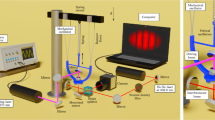Conclusions
-
1)
We have investigated a diffraction-radiation oscillator with energy taken off through a coupling hole situated outside the center of the spherical mirror of the DRO open resonaton. It has been shown that the oscillator-load coupling coefficient may be varied over a wide range for all modes excited in the CR of the oscillator by rotating one of the mirrors about the OR axis, as well as by varying the distance between the mirrors.
-
2)
Location of the coupling hole outside the center of the spherical OR mirror permits a significant increase in the dimensions of the hole itself as compared with similar apertures located at the center. As an example, in our experiments using a 4-mm DRO with semisymmetric OR the noncentral coupling hole had a circular cross section with a 4 mm-diameter, while for analogous DRO the central hole measured 0.1×3.6 mm2. This simplifies the fabrication of the oscillator and increases the accuracy with which a prescribed coupling is obtained.
-
3)
It has been demonstrated logically and verified experimentally that the oscillator-load coupling coefficient may be determined by measuring the starting currents for a matched load and for a short-circuit piston, while the optimal coupling coefficient may be estimated from the ratio of the difference of the working and minimum starting currents to their sum.
-
4)
Comparing the experimentally measured coupling coefficient and the calculated field intensity at the site of the coupling hole, we see that the actual width of the field spot along the 0x axis for the TEM02q and TEM12q modes is larger than calculated. As a consequence, Eq. (3) gives a description of the OR field that is only qualitatively correct.
Similar content being viewed by others
Literature Cited
I. M. Balaklitskii, B. K. Skrynnik, O. A. Tret'yakov, and V. P. Shestopalov, Ukrainsk. Fiz. Zh.,14, No. 4, 539 (1969).
I. M. Balaklitskii, I. D. Revin, B. K. Skzynnik, A. S. Sysoev, O. A. Tret'yakov, and V. P. Shestopalov, Reports to the Seventh All-Union Conference, Microwave Electronic Devices and Their Applications [in Russian], Tomsk (1972), p. 259.
I. M. Balaklitskii, V. G. Kurin, B. K. Skrynnik, and V. P. Shestopalov, Prib. Tekh. Éksp., No. 5 (1974).
I. M. Balaklitskii, I. D. Reyin, B. K. Skrynnik, A. S. Sysoev, O. A. Tret'yakov, and V. P. Shestopalov, Izv. Vyssh. Uchebn. Zaved., Radiofiz.,16, No. 2, 235 (1973).
G. Birnbaum, Lasers [Russian translation], Sovet-skoe Radio, Moscow (1967).
J. L. Altman, Microwave Circuits, Van Nostrand Reinhold (1964).
D. E. Samsonov. Fundamentals of the Design and Construction of Magnetrons [in Russian], Sovet-skoe Radio (1974).
B. K. Skrynnik, Radio Engineering [in Russian], No. 34, Izd. KhGU, Khar'kov (1975), p. 133.
Additional information
Institute of Radiophysics and Electronics. Academy of Sciences of the Ukrainian SSR. Translated from Izvestiya Vysshikh Uchebnykh Zavedenii, Radiofizika, Vol. 19, No. 1, pp. 128–134, January, 1976.
Rights and permissions
About this article
Cite this article
Kurin, V.G., Skrynnik, B.K. & Shestopalov, V.P. Uptimizing the coupling of a diffraction-radiation oscillator to its load. Radiophys Quantum Electron 19, 88–92 (1976). https://doi.org/10.1007/BF01038414
Received:
Issue Date:
DOI: https://doi.org/10.1007/BF01038414




